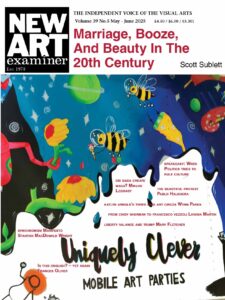
Megan Euker 'Untitled' Oil om Panel
Steven Carrelli
A year ago this month my wife Louise and I sat at the kitchen table of our friends Adam and Charlene Fung in Fort Worth, Texas, and we played a game called Pandemic. It is a cooperative game in which each player has a different specialty, and their task is to work together to stop a global pandemic. The players either win collectively, ending the spread of the disease, or lose collectively. As I recall, we defeated the pandemic that evening.
Today, we are confined to our respective homes – the Fungs in Fort Worth, and Louise and I in Chicago – as COVID-19 increases its reach daily, and we consult maps online that look disconcertingly like the game board on that kitchen table. Art institutions, like nearly everywhere else, have closed to the public, and those of us who teach have switched practically overnight to online-only instruction.

Oil om Panel
As a painter, I wonder how the values of painting can be taught in such a format. Of course, we must do it under these circumstances. But painting is so much more than image, shape and color – much more than those qualities that are reproducible and transmissible via photographs and digital media. In a time of social distancing and virtual exhibitions, how does one cultivate the necessary sensitivity to the immediate, physical aspects of painting that make it a vital art form?
Perhaps even more importantly, I am prompted by these circumstances to wonder why I still believe painting to be a vital art form. What does painting have to offer at the present time, and why do I think that the sensitivity it demands of us is still worth cultivating?
In the hallway of my home hangs a seven-inch-square, untitled painting from 2008 by Megan Euker, a Chicago-based artist. Thickly painted in oil on a wooden panel, it depicts three standing bathers, their backs turned to us. The central figure is painted in broad, swift strokes of red and brown, the furrow of his spine a single dark brown swipe of the brush. Arms are indicated by as few as three or four bold contrasting strokes. The water and land in the foreground are composed of wide sweeps of blue, black, and sandy ochre, while thick dabs of yellow-green suggest foliage in the distance. The paint piles up in lumps and pools, creating a textured surface that has a tactile, weighty presence.
Hanging below Euker’s painting is Whirlpool (ominous), also from 2008, by Adam Fung. The surface of Fung’s tiny (4.5 x 5.75 inches) painting is as texturally complex as Euker’s, but completely unlike it. Swirling concentric waves of water are painted with delicate hatches of tightly harmonized colors ranging from pale warm blues tinged with yellow to deep blue-violets. This whole surface is then thickly varnished to a glossy, uniformly smooth finish that both deepens the colors and increases the viewer’s distance from the subject. While Euker’s painting depicts a deep space, its painted surface projects in relief into our own tactile space. Fung’s painting, by contrast, suggests a window onto space that is utterly inaccessible. Its delicate, sensuous surface invites touch, but to touch it would be like pressing one’s fingers against a glass pane. It separates our space from the space of the painting, enticing us to move closer while pushing the depicted space ever further out of reach.
The galleries and museums are closed due to a global pandemic, and I am walking up and down the hall of my apartment looking at paintings. Why should I care about this so much? Why should I ask you to care? I, and many of the people around me, have lost friends to this virus, and we are unable to mourn together in public. At a time when people are concerned about saving lives, I ask myself why anyone should give a rip about painting. So what if we can’t visit a gallery or museum to look at paintings in this moment? Isn’t this just a luxury? I certainly can’t deny the role of privilege – or the lack of it – in both access to art and vulnerability in a crisis. Still, here I am looking at these little paintings, these tiny gems that hang on my wall and keep me company. And I’m reaching through video conference meetings and online teaching platforms to impress upon my students the fine points of line weight, mark-making, touch. Why?
What these paintings have in common is ‘presence’. They embody something of the human intelligence that made them. They are the products of care embedded in a surface through touch. They speak to us as physical bodies, and remind us of how that physicality connects us to the people around us and to the larger world.
In a time when it is dangerous to touch our friends, the sensitive touch embodied in a good painting is a genuine grace.
Volume 35 no. 1 September / October 2020


Sending article to artist
son in FK.
A wonderful article. Thank you, Steven.
There is simply no substitute for being “in person” to take in art. There is no real virtual art world. This is a very difficult idea “for many” to grasp. Everything, all the art, you see on line- is compromised. The exception may be “digital art itself” which may have to do with the aesthetic of “compromising itself”. Keep painting!!!!
Beautiful, sincere, & insightful, as always Steve!
Concise and beautiful! As I have turned from painting to digital imagery I have gained in that I can create dozens of new ideas while friends create one or two paintings. But their paintings have a visual force that graphics created as light cannot achieve. Prior to Newton color to painters was not light but a property embedded in physical material. As such color theory back then comprised the element known as luster. Yellow white and black on coats of arms were originally gold silver and sable to yield a far more powerful visual effect.
“They are the products of care embedded in a surface through touch.” Steve’s writing teaches us by penetrating to the core of his subjects, so is always a joy to read.